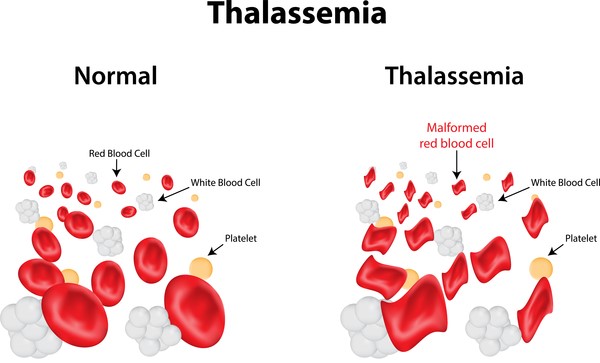Sevan Hewa Othman
Faculty of Pharmacy
Thalassemia is the name given to a globin gene disorder that results in a diminished rate of synthesis of one or more of the globin chains and, consequently, a reduced rate of synthesis of the hemoglobin or hemoglobins of which that chain constitutes a part. Beta-thalassemia syndromes are a group of hereditary blood disorders characterized by reduced or absent beta globin chain synthesis. The condition was first described by Cooley and Lee in 1925. More than a decade later, Wintrobe and colleagues described milder form of Cooley’s anemia in both parents of the children with classic Cooley’s anemia. The word thalassemia is described from Greek word “thalas” meaning sea and “haimas” meaning blood because all early cases were reported in children of Mediterranean origin.
Thalassemia is a term that refers to a group of genetic disorders characterized by insufficient production of hemoglobin, wherein there is a defect in the synthesis of hemoglobin. It is sometimes called Mediterranean anemia. To understand how thalassemia affects the human body, we must first understand a little about how blood is made. If the body doesn’t produce enough of alpha and a beta chains of globin, the red blood cells do not form properly and cannot carry sufficient oxygen. The result is anemia that begins in early childhood and lasts throughout life. Involved genes are those that control the production of alpha and beta globins contained in hemoglobin. The two main types of thalassemia, alpha and beta, are named for the two protein chains that make up normal hemoglobin. Thalassemia is not a single disorder but a group of related disorders that affect the human body in different ways. It can be classified according to symptoms or to the affected genes. Thalassemia major that is studied in this work is inherited from both parents. Beta thalassemia tends to be more common in people from many ancestry including Mediterranean and Arabian Peninsula.
Beta Thalassemia:
Thalassemia major (Cooley’s Anemia) refers to a severe clinical phenotype that occurs when patients are homozygous or compound heterozygous for more severe beta chain mutations (e.g. severe B+/B+ mutations, B+/B0, B0/B0)
Thalassemia intermedia is an in between clinical phenotype with heterogeneous genetic mutations that still allow for some Beta chain production (e.g. B+/B0, B+/B+). Some rare cases also exist in which both beta and alpha mutations coexist.
Diagnosis of beta thalassemia
Thalassemia is a globin gene disorder that results in a diminished rate of synthesis of one or more of the globin chains. About 1.5% of the global population (80 to 90 million people) are carriers of beta Thalassemia. More than 200 mutations are described in beta thalassemia. However not all mutations are common in different ethnic groups. The only effective way to reduce burden of thalassemia is to prevent birth of homozygotes. Diagnosis of beta thalassemia can be done by fetal DNA analysis for molecular defects of beta thalassemia or through fetal blood analysis. Hematopoietic stem cell transplantation is the only available curative approach for Thalassemia. Many patients with thalassemia in underdeveloped nations die in childhood or adolescence. Programs that provide acceptable care, including transfusion of safe blood and supportive therapy including chelation must be established.
References:
- Dogerthy, P. Einarson, T; Koren, G. (1997), Blood, 90:894.
- K. Al-Hakim, et al, (2009), Study of some biochemical Parameters in Iraqi Male Children with Thalassemia, Ibn-Haitham J. for Pure & Appl Sci, Vol. 22(4).
- Runa Jha, (2014), Beta thalassemia – a review, Journal of Pathology of Nepal, Vol. 4, 663 – 671.


